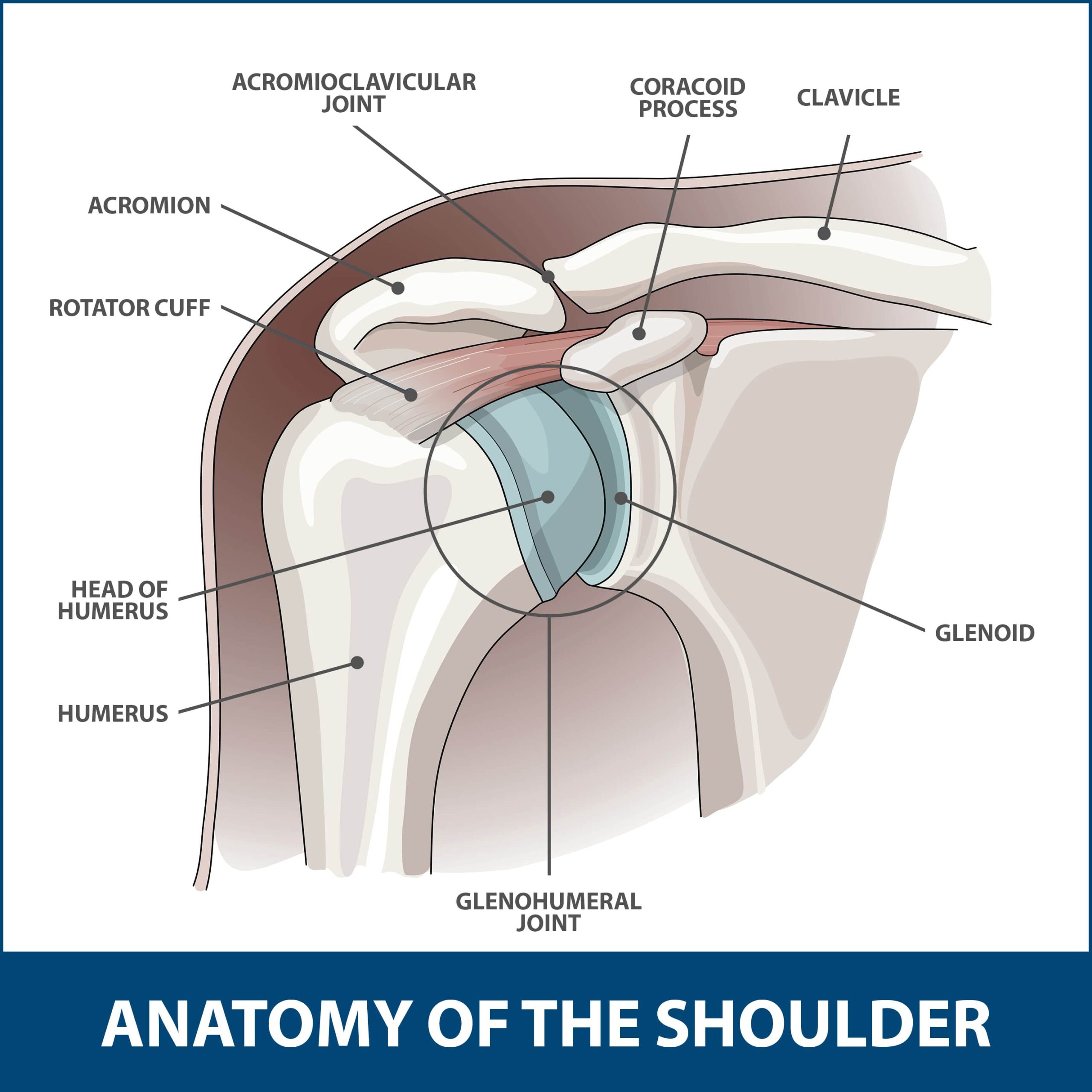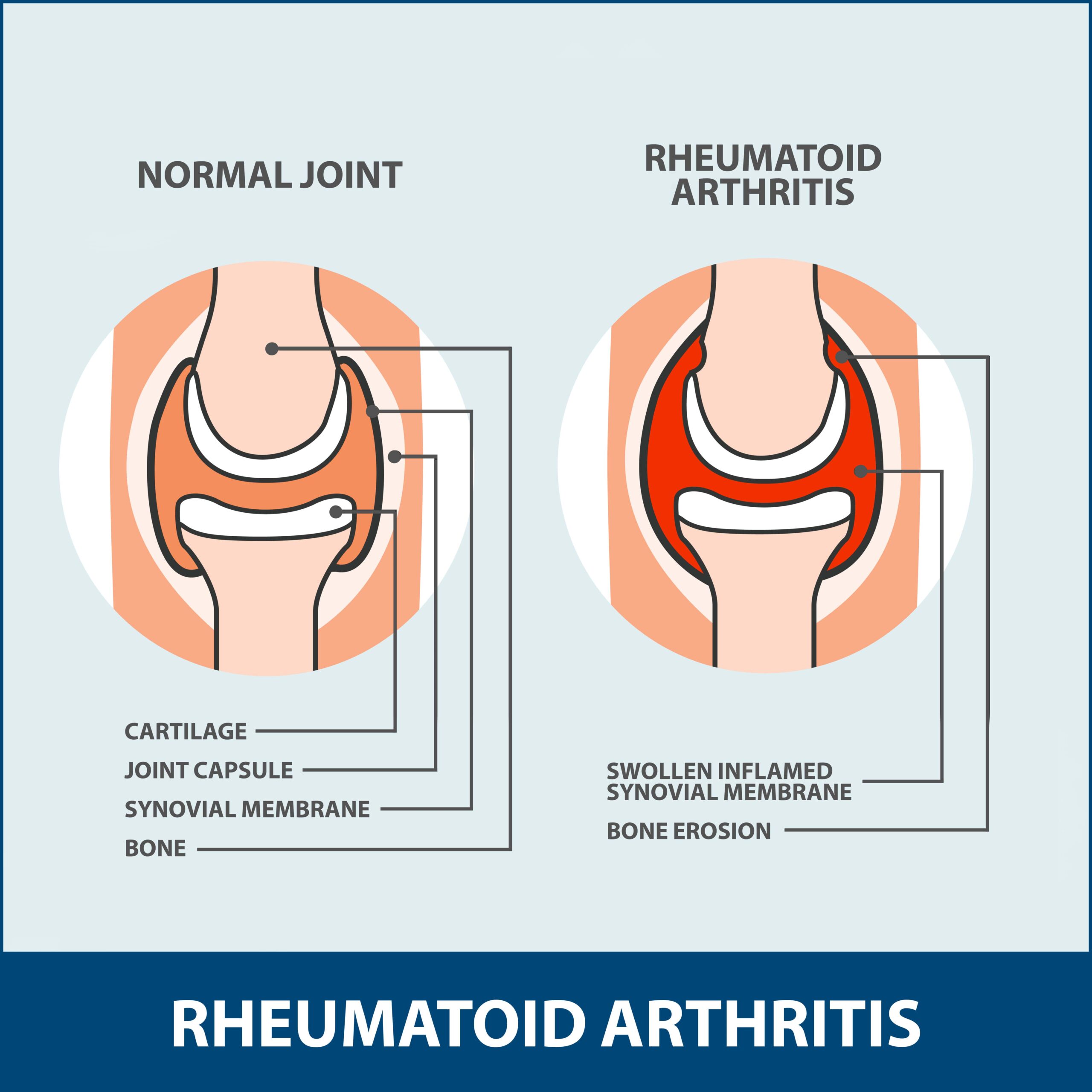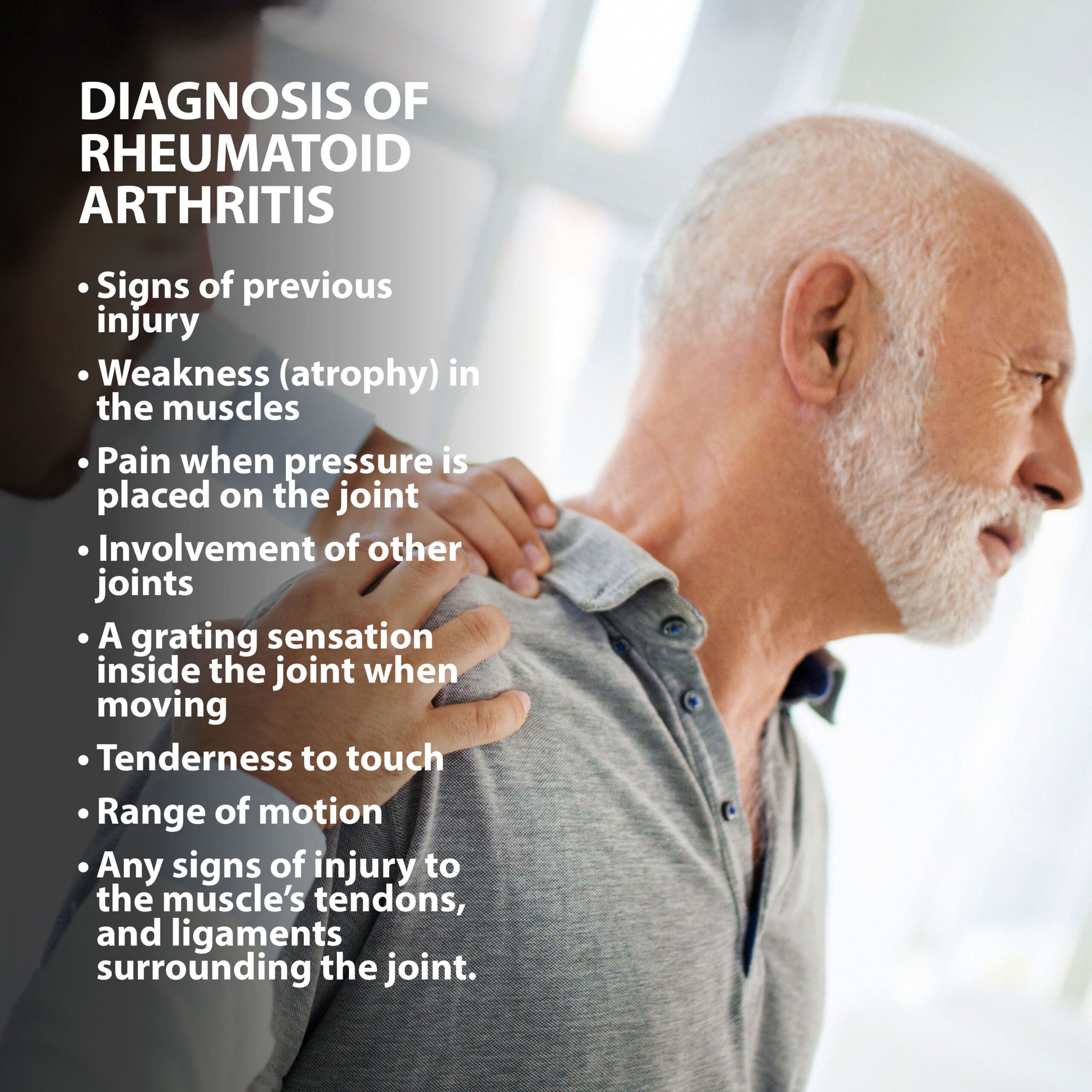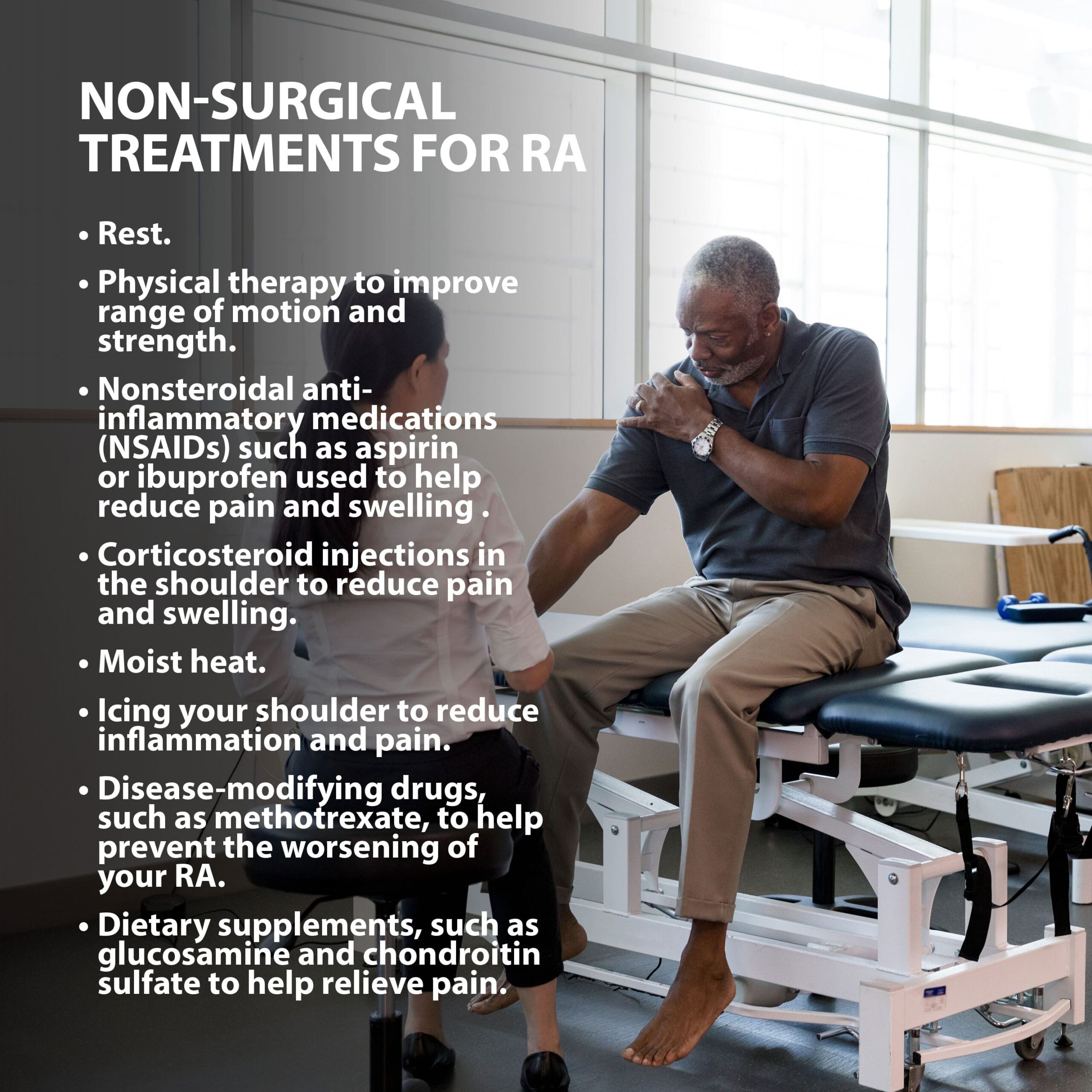Rheumatoid Arthritis In the Shoulder
OVERVIEW
Rheumatoid Arthritis (RA) of the shoulder is an autoimmune disease that results in your body essentially attacking healthy cells – specifically the ones found in the joints – as if they are a disease or intruder in the body. This causes the destruction of the tissue and cartilage in the shoulder, resulting in the bones rubbing together. This disease causes pain and swelling that worsens over time. Unfortunately, there is no known cure for RA of the shoulder. But there are many treatment options available to help you manage your pain and stay active.
ANATOMY
Your shoulder is made up of three bones: the upper arm bone (humerus), the collarbone (clavicle), and the shoulder blade (scapula). The head of your upper arm bone fits into a round socket (glenoid) in your shoulder blade. A combination of muscles and tendons (known as the rotator cuff) keeps your arm bone in the center of your shoulder socket.
The joints in your body have a lining covering them (synovium) that lubricates the joints, making it easier to move.
DESCRIPTION
Rheumatoid Arthritis (RA) is an autoimmune disease that causes your immune system to attack your own tissues – more specifically the shoulder tissue and joints. In RA, the defenses that protect the body from infection damage healthy tissue (such as cartilage and ligaments) instead. This causes the bones of the shoulder joint to rub together. This friction causes pain and potentially even bone spurs. Typically, it will affect both shoulders at the same time. When this particular type of arthritis affects the shoulder, it causes the lining of the joint to swell, also resulting in pain and stiffness.
There are two joints in the shoulder, both of which may be affected by arthritis. One joint is where the collarbone meets the tip of the shoulder blade. This is known as the acromioclavicular (AC) joint.
The second joint is the glenohumeral joint, where the head of the upper arm bone fits into the shoulder blade. To provide you with effective treatment, your physician will determine the joint experiencing pain and what type of arthritis you have.
The cause of rheumatoid arthritis is not fully understood. Genetics and environmental factors may both play a role. Unfortunately, there is no known cure for RA of the shoulder. But there are many treatment options available to help you manage your pain and stay active.

SYMPTOMS
The main symptom of Rheumatoid Arthritis of the shoulder is pain that is brought on by any activity which progressively worsens. The other symptom of RA is a decrease in the range of motion. Over time, it may become increasingly difficult to lift your arm. You may hear a grinding, clicking, or snapping sound (known as crepitus) as you move your shoulder.
As the disease progresses, any movement of the shoulder causes pain. Night pain is common and sleeping can be difficult. Redness and warmth in the shoulder area are also common symptoms of RA of the shoulder.

DIAGNOSIS
Your Florida Orthopaedic Institute physician will take a look at your symptoms, medical history, and overall health. After that, a physical examination. During this examination, your physician will look for:
- Signs of a previous injury.
- Weakness (atrophy) in the muscles.
- Pain when pressure is put on the joint.
- Involvement of other joints.
- A grating sensation inside the joint when moving.
- Tenderness to touch.
- Range of motion.
- Any signs of injury to the muscle’s tendons and ligaments surrounding the joint.

Your physician may also order X-rays to help better determine your diagnosis. X-rays are imaging tests that create in-depth pictures of dense structures, such as bone. If you have RA of the shoulder, this test will show a narrowing of the joint space, changes in the bone, and the formation of bone spurs (osteophytes).
Another tactic your physician may use to determine your diagnosis is to inject a local anesthetic into the joint. If it temporarily relieves the pain, then the diagnosis of RA is supported.
TREATMENT OVERVIEW
There are both surgical and non-surgical treatments available to help improve your symptoms and prevent your Rheumatoid Arthritis from worsening. Physicians recommend non-surgical treatments first as they are the least invasive and tend to have good results. If non-surgical treatments are ineffective, then surgical procedures may be necessary.
NON-SURGICAL TREATMENTS
The initial treatment plan for Rheumatoid Arthritis of the shoulder is non-surgical. Your Florida Orthopaedic Institute physician may select any of the following to help relieve the symptoms of your RA:
- Rest.
- Physical therapy to improve range of motion and strength.
- Nonsteroidal anti-inflammatory medications (NSAIDs) such as aspirin, Advil/Motrin (ibuprofen) or Aleve (naproxen) to help reduce pain and swelling.
- Corticosteroid injections in the shoulder to reduce pain and swelling.
- Moist heat.
- Icing your shoulder to reduce inflammation and pain.
- Disease-modifying drugs, such as methotrexate, to help prevent the worsening of your RA.
- Biologic treatments (disease-modifying antirheumatic drugs [DMARDs] – made with biotechnology) such as Actemra, Cimzia, Enbrel, Humira, Kineret, Orencia, Remicade, Rituxan, and Simponi. They are genetically engineered to act like natural proteins in your immune system.
- Dietary supplements, such as glucosamine and chondroitin sulfate to help relieve pain.

SURGICAL TREATMENTS
Your physician may consider surgery if none of the non-surgical treatments above relieve your symptoms. The surgical treatments used to treat RA of the shoulder include:
- Tendon repair. Inflammation and joint damage may cause tendons around your joint to loosen or rupture. In this procedure, the tendons around your shoulder joint are repaired.
- Joint fusion. Surgically fusing a joint may be necessary to stabilize or realign a joint and for pain relief when a joint replacement isn’t an option.
- Total joint replacement. During joint replacement surgery, your surgeon removes the damaged parts of your joint and inserts a prosthesis made of metal and plastic.
Lastly, the procedure chosen is highly dependent on the severity of your RA of the shoulder.
NEXT STEPS
Contact your Florida Orthopaedic Institute physician today to learn more about Rheumatoid Arthritis Shoulder.
Areas of Focus
- Shoulder
- AC Joint Injuries
- Atraumatic Shoulder Instability
- Bankart Repair
- Bicep Tendon Tear
- Bicep Tenodesis
- Broken Collarbone
- Bursitis of the Shoulder (Subacromial Bursitis)
- Calcific Tendinitis of the Shoulder
- Clavicle Fractures
- Dislocated Shoulder
- Fractures Of The Shoulder Blade (Scapula)
- Glenoid Labrum Tear
- Impingement Syndrome of the Shoulder
- Little League Shoulder
- Reverse Total Shoulder Replacement
- Rheumatoid Arthritis (RA) of the Shoulder
- Rotator Cuff Tears
- Shoulder Arthritis
- Shoulder Arthroscopy
- Shoulder Injury: Pain In The Overhead Athlete
- Shoulder Replacement
- Shoulder Separations
- Shoulder Socket Fracture (Glenoid Fracture)
- SLAP Tears & Repairs
- Subacromial Decompression
- Trapezius Strain (Muscle Strain of The Upper Back)
- Traumatic Shoulder Instability
The following Florida Orthopaedic Institute physicians specialize in Rheumatoid Arthritis (RA) of the Shoulder:
Specialties
- AC Joint Injuries
- Achilles Tendinitis - Achilles Insertional Calcific Tendinopathy (ACIT)
- Achilles Tendon Rupture
- Achilles Tendonitis
- ACL Injuries
- Ankle Fracture Surgery
- Ankle Fractures (Broken Ankle)
- Ankle Fusion Surgery
- Anterior Cervical Corpectomy & Discectomy
- Arthroscopic Articular Cartilage Repair
- Arthroscopic Chondroplasty
- Arthroscopic Debridement of the Elbow
- Arthroscopy Of the Ankle
- Articular Cartilage Restoration
- Artificial Disk Replacement (ADR)
- Aspiration of the Olecranon Bursa - Fluid In Elbow
- Atraumatic Shoulder Instability
- Avascular Necrosis (Osteonecrosis)
- Bankart Repair
- Basal Joint Surgery
- Bicep Tendon Tear
- Bicep Tenodesis
- Bone Cement Injection
- Bone Growth Stimulation
- Bone Health Clinic
- Broken Collarbone
- Bunions
- Bursitis of the Shoulder (Subacromial Bursitis)
- Calcific Tendinitis of the Shoulder
- Carpal Tunnel Syndrome
- Charcot Joint
- Chiropractic
- Clavicle Fractures
- Colles’ Fractures (Broken Wrist)
- Common Foot Fractures in Athletes
- Community Outreach
- Cubital Tunnel Syndrome
- De Quervain's Tenosynovitis
- Deep Thigh Bruising
- Degenerative Disk Disease
- Diffuse Idiopathic Skeletal Hyperostosis (DISH)
- Discectomy
- Discitis Treatment & Information
- Dislocated Shoulder
- Dupuytren’s Disease
- Elbow
- Elbow Bursitis
- Elbow Injuries & Inner Elbow Pain in Throwing Athletes
- Epidural Injections for Spinal Pain
- Finger Dislocation
- Flexor Tendonitis
- Foot Stress Fractures
- Foot, Ankle & Lower Leg
- Foraminotomy
- Fractured Fingers
- Fractures Of The Shoulder Blade (Scapula)
- Fractures Of The Tibial Spine
- Functional Nerve Transfers of The Hand
- Ganglion Cysts
- General Orthopedics
- Glenoid Labrum Tear
- Golfer's Elbow
- Groin Strains and Pulls
- Growth Plate Injuries Of The Elbow
- Hallux Rigidus Surgery - Cheilectomy
- Hammer Toe
- Hamstring Injuries
- Hand & Finger Replantation
- Hand & Wrist
- Hand Nerve Decompression
- Hand Skin Grafts
- Hand, Wrist, Elbow & Shoulder
- Heat Injury/Heat Prostration
- High Ankle Sprain (Syndesmosis Ligament Injury)
- Hip & Thigh
- Hip Arthroscopy
- Hip Dislocation
- Hip Flexor Strains
- Hip Fractures
- Hip Hemiarthroplasty
- Hip Impingement Labral Tears
- Hip Muscle Strains
- Hip Pointers and Trochanteric Bursitis
- Hyperextension Injury of the Elbow
- Iliopsoas Tenotomy
- Iliotibial Band Syndrome
- Impingement Syndrome of the Shoulder
- Interlaminar Implants
- Interlaminar Lumbar Instrumental Fusion: ILIF
- Interventional Pain Management
- Interventional Spine
- Intraarticular Calcaneal Fracture
- Joint Replacement
- Knee & Leg
- Kyphoplasty (Balloon Vertebroplasty)
- Kyphosis
- Labral Tears Of The Hip (Acetabular Labrum Tears)
- Laminectomy: Decompression Surgery
- Lateral Collateral Ligament (LCL) Injuries
- Lisfranc Injuries
- Little League Shoulder
- LITTLE LEAGUER'S ELBOW (MEDIAL APOPHYSITIS)
- Lumbar Epidural Steroid Injection
- Lumbar Interbody Fusion (IBF)
- MACI
- Mallet, Hammer & Claw Toes
- Medial Collateral Ligament Injuries
- Meniscus Tears
- Metatarsalgia
- Minimally Invasive Spine Surgery
- Morton’s Neuroma
- Muscle Spasms
- Muscle Strains of The Calf
- Nerve Pain
- Neuromas (Foot)
- Neurosurgery
- Olecranon Stress Fractures
- Orthopaedic Total Wellness
- Orthopaedic Trauma
- Orthopedic Physician Or A Podiatrist? Definition of a Podiatrist
- Osteoarthritis of the Hip
- Osteoporosis
- Outpatient Spine Surgery
- Partial Knee Replacement
- Patellar Fracture
- Pelvic Ring Fractures
- Peripheral Nerve Surgery (Hand) Revision
- Pinched Nerve
- Piriformis Syndrome
- Piriformis Syndrome
- Plantar Fasciitis
- Plastic Surgery
- Podiatry
- Primary Care Sports Medicine
- Quadriceps Tendon Tear
- Radial Tunnel Syndrome (Entrapment of the Radial Nerve)
- Revascularization of the Hand
- Reverse Total Shoulder Replacement
- Rheumatoid Arthritis (RA) of the Shoulder
- Rheumatoid Arthritis Of The Hand
- Robotics
- Rotator Cuff Tears
- Runner's Knee
- Sacroiliac Joint Pain
- Sciatica
- Scoliosis
- Senior Strong
- Shin Splints
- Shoulder
- Shoulder Arthritis
- Shoulder Arthroscopy
- Shoulder Injury: Pain In The Overhead Athlete
- Shoulder Replacement
- Shoulder Separations
- Shoulder Socket Fracture (Glenoid Fracture)
- SLAP Tears & Repairs
- Spinal Fusion
- Spine
- Spondylolisthesis and Spondylolysis
- Sports Foot Injuries
- Sports Hernias (Athletic Pubalgia)
- Sports Medicine
- Sports Wrist and Hand Injuries
- Sprained Ankle
- Sprained Wrist Symptoms and Treatment
- Subacromial Decompression
- Sudden (Acute) Finger, Hand & Wrist Injuries
- Targeted Muscle Reinnervation (TMR)
- Tendon Transfers of The Hand
- Tennis Elbow Treatment
- Thigh Fractures
- Thigh Muscle Strains
- Thumb Ulnar Collateral Ligament Injuries
- Total Ankle Replacement
- Total Hip Arthroplasty
- Total Hip Replacement - Anterior Approach
- Total Knee Replacement Surgery
- Trapezius Strain (Muscle Strain of The Upper Back)
- Traumatic Shoulder Instability
- Tricep Pain & Tendonitis
- Trigger Finger
- Turf Toe
- UCL (Ulnar Collateral Ligament) Injuries
- Ulnar Neuritis
- Valgus Extension Overload
- Vertebroplasty
- WALANT (Wide Awake Local Anesthesia No Tourniquet)
- Whiplash and Whiplash Associated Disorder (WAD)
- Wound Care
- Wrist Arthroscopy
- Wrist Fractures
- Wrist Tendonitis
Services
- Physical Medicine & Rehabilitation
- Physical Therapy
- Primary Care Sports Medicine
- PROMs (Patient-Reported Outcome Measures)
- Same-Day Orthopaedic Appointments Now Available
- Sports Medicine
- Sports-Related Concussion Treatment
- Telehealth Page
- Telemedicine
- Workers' Compensation
- Workers' Compensation Dispensary
- X-Ray
